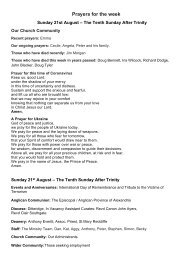You also want an ePaper? Increase the reach of your titles
YUMPU automatically turns print PDFs into web optimized ePapers that Google loves.
at church development<br />
PROJECT 450 DEVELOPMENTS<br />
— RHYS WILLIAMS<br />
RESEARCH ASSISTANT<br />
P<br />
ROJECT 450 WILL ENTER A SIGNIFICANT NEW PHASE during the<br />
first half of <strong>2019</strong>, with the production of a Project 450 masterplan<br />
that will provide the congregation, the community, visitors to <strong>St</strong> <strong>Mary</strong><br />
<strong>Redcliffe</strong> and statutory stakeholders with a clearer picture of what the<br />
church’s new facilities will look like and do.<br />
The masterplan will be built on the wealth of information that we have<br />
accumulated during the last few years. As previously reported, during<br />
his time the church has commissioned a series of studies and reports<br />
that have:<br />
• catalogued and assigned significance to <strong>St</strong> <strong>Mary</strong> <strong>Redcliffe</strong>’s heritage<br />
assets, allowing the church to build a clearer picture of how it might<br />
display treasures that either are not currently on display or might be<br />
displayed more effectively;<br />
• collected its stories, related these to broad themes, and looked at<br />
how the story of the church might be better presented to church<br />
users;<br />
• analysed the church’s role in the community and looked at how Project<br />
450 can help the organisation better respond to local deprivation<br />
and need;<br />
• evaluated the church’s potential for attracting finance from third<br />
party funding organisations and private individuals;<br />
• looked at the potential form of the church’s new buildings and how<br />
they can respond to organisational needs.<br />
The last of the preparatory studies — the Project 450 business plan — will<br />
look at financial feasibility, organisational capacity and long-term sustainability.<br />
The church has appointed Glevum Consulting, an experienced<br />
heritage business consultancy, to produce the business plan. Since<br />
2002, Glevum has helped secure £70 million of HLF and private donor<br />
funding, and directly helped deliver £40 million of capital projects and<br />
activity plans. Recently the organisation has provided funding and project<br />
management services to Bristol Old Vic to support its successful development<br />
project.The business plan will include the following elements:<br />
• an analysis of the structure and operational characteristics of the<br />
church, including its purpose and aims, its legal status, its membership,<br />
its organisational structure, and the roles of its staff and volunteers;<br />
• an analysis and evaluation of the church’s experience: its achievements<br />
and ability to deliver Project 450. This will also look at the church’s partnership<br />
work with both private and public organisations;<br />
• an overview of the development of Project 450, including commissioned<br />
studies and research, consultation and the budget to date;<br />
• an analysis of Project 450 strategy and aims, outcomes and lifespan,<br />
including how the project relates to the church’s organisational aims<br />
and local, regional and national strategies for regeneration and heritage;<br />
• detailed information on the capital project, the development programme<br />
and critical path, highlighting the church’s heritage USPs (unique selling<br />
points) and the main commercial and community drivers;<br />
• a market appraisal, looking at the current heritage market, the target<br />
market, competition, and a competitive strategy;<br />
• financial modelling, looking at commercial income and expenditure,<br />
including income forecasts and return on investments for all areas of<br />
the business model, integrating the new capital elements of the scheme;<br />
• a review of governance, management, staff and volunteers;<br />
• a detailed risk analysis;<br />
• a monitoring and evaluation strategy;<br />
• an organisational impact and transition analysis.<br />
This work will help to define the scope and scale of parts of the development<br />
that are linked with income-generating activities: for example, the<br />
shop and café. It will also help us to answer the question of whether it<br />
is feasible to rehouse William Hogarth’s altarpiece as part of the project,<br />
by looking at issues such as organisational impact and sustainability.<br />
It is estimated that the business plan will be finalised in around six to<br />
eight weeks, at which point project 450 architects Purcell will use the<br />
information it contains to refine the design and produce the masterplan.


















